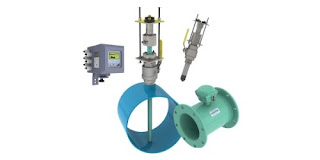Many industrial processes involve the movement of fluid product components, either liquid or gaseous, through pipes. Because processing is about control, an input to the facility's management, measurement, or data logging centers will answer the query, "How much is going through that pipe?"
In the industrial process measurement and control industry, there are several ways for quantifying flow, each with unique characteristics that may be useful under certain operating situations. All flow measuring methods are indirect because the actual measurement is of a character influenced predictably by a change in the media flow. Flow measurement is a critical component that, when paired with other fluid properties, is used to calculate the total mass of a fluid passing through the measurement site.
The variable area meter, commonly known as a rotameter and VA meter, is a tried and true flow measuring device that operates by creating an equilibrium between an upward force created by fluid motion and a downward force, gravity. A tapering glass or metal tube encases a specifically shaped float, also known as a shaped weight, in the device. VA meters must be positioned vertically, with the media flowing upward from the bottom, so that the gravity force required for functioning is correctly aligned with the flow direction. As fluid flows upward via the precisely tapered tube, drag is created on the float enclosed within the tube, pulling it upward. As the float rises, the open space between the float and the tube wall expands, causing the fluid velocity and drag force to decrease. The flow velocity within the tube will cause the weight to climb for any given flow volume until the drag force generated by the flow reaches equilibrium with the countervailing power of gravity on the float. The tube and float are well designed, allowing for an immediate indication of flow volume.
Variable area flowmeters have the following operating characteristics:
- There is no need for external power or fuel for functioning.
- Vertical installation is required, with flow arriving at the bottom.
- Meters are calibrated to a given chemical and temperature.
- The operation is stable and has a modest pressure drop.
- For operation, constant gravity is required.
- Flow rate can be read locally using a meter or a scale inscribed on the tube.
- The visibility of the float through the medium is required for unit flow readings using glass tubes.
- For industrial flow metering equipment, accuracy is relatively low.
- Inexpensive upkeep, simple construction, and low comparative cost.
Brooks Instrument, a world-renowned maker of flow, pressure, and level measurement equipment, created a brief paper highlighting the parameters to consider when specifying a VA meter and how each aspect influences the unit's performance. The description is realistic and straightforward to grasp. It is suggested reading for all process stakeholders who want to improve their flow measuring skills.
For more information about variable area flow meters contact Miller Energy. Call 800-631-5454 or visit https://millerenergy.com.






